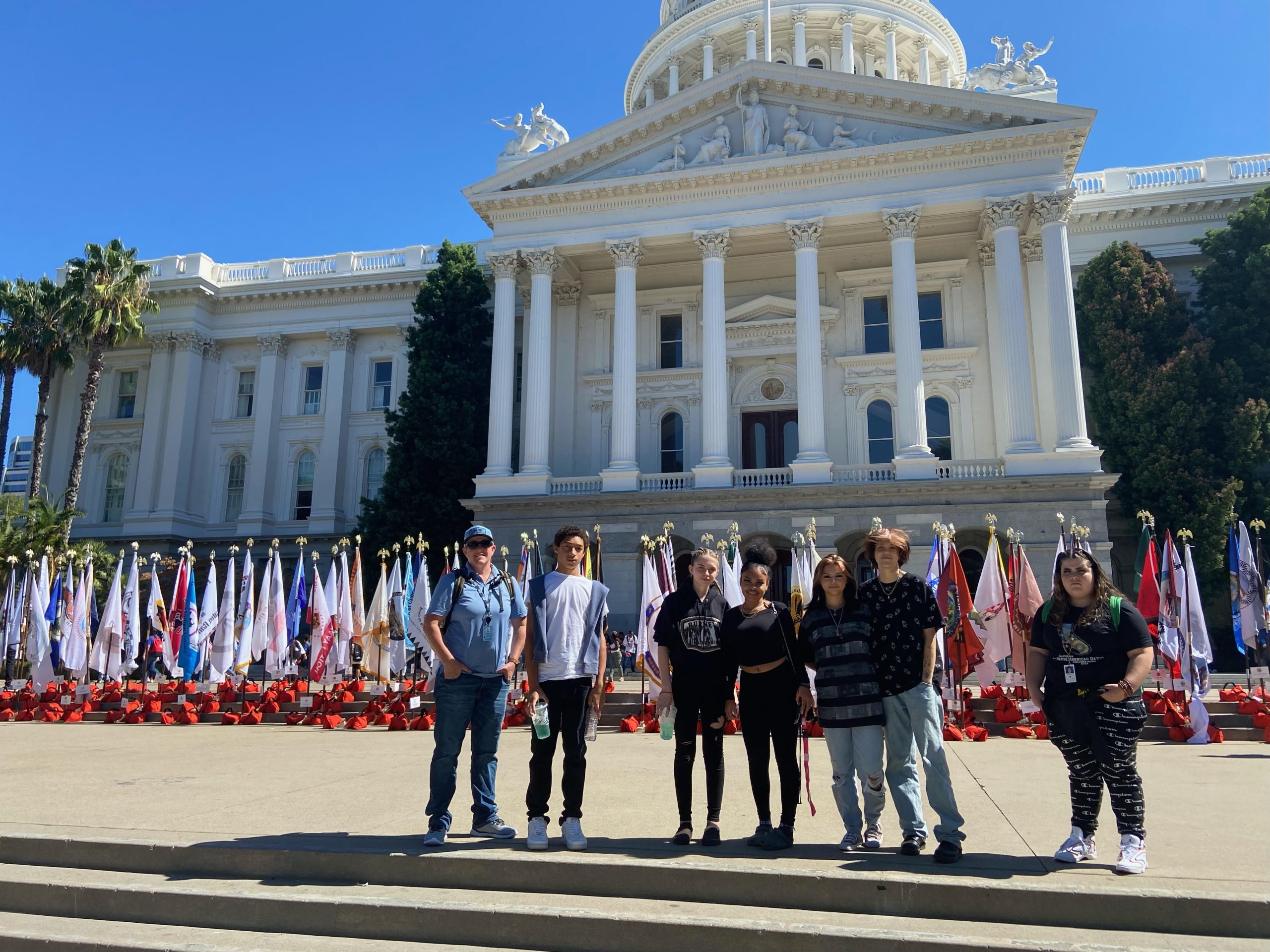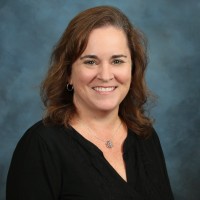Listening Leads to Deeper Inclusion for Native Students

Shasta County American Indian Advisory Statement of Purpose: To support and encourage a more inclusive and robust educational experience for Shasta County students by accurately depicting Native American history, correcting myths, and misconceptions, combating prejudice and promoting safety, appreciation, celebration, and honoring of the history, culture, and continuing contributions of Native Americans.
Introduction
Percy Tejada, a member of the Greenville Rancheria of Maidu Indians, removed the handmade five-strand pine nut necklace, which had been made for him by another highly respected tribal community member, and he placed it around the neck of Shasta County Schools Superintendent Judy Flores. “This is an acknowledgment of the commitment not just to listen to the needs of our local Native community, but to pursue an open relationship whereby Supt. Flores could advocate for the students and the families within Shasta County,” Tejada said. “Gifts are given in a good way from person to person, so that the medicine may travel in those things. I was honored to have this gift for a while and I hope that it brings joy to the receiver.”
Before Flores’ tenure as school superintendent wrapped up in June, tribal members reflected on the breadth of work that was accomplished on behalf of Native students and their families, beginning quite literally on her first day in office. On that day in 2017, Flores was visited by Rod Lindsay, Executive Director for the Local Indians for Education (LIFE) Center and a member of the Me-wuk/Paiute tribe. There’s a big problem in Shasta County, he told her. Native students need more support in schools, and he was certain that together, they could make that happen.
So they did.
Shasta County in rural, far Northern California has the second-highest number of Native students in the state, and the 10th highest as a percentage of student enrollment.”
Listening Sessions
Shasta County in rural, far Northern California has the second-highest number of Native students in the state, and the 10th highest as a percentage of student enrollment. As Flores began studying chronic absenteeism among Shasta County public school students, she discovered an alarming trend–Native students had a much higher rate of absenteeism than any other group of students. In some districts, more than 30% of Native students were chronically absent. She shared that data at a state meeting, and Dr. Niki Sandoval, who had increased graduation rates from 50 to 100 percent among students from the Chumash Tribe in Santa Barbara County, agreed to help Flores with a listening session in Shasta County in January 2019. Some key takeaways were that Native students and families felt a lack of trust, a lack of belonging, and a lack of accurate (or any) information about local tribes in the curriculum. “I told them at the end of the listening session that this was not the end of the conversation, this was just the beginning of work we would do together,” Flores said.
We don’t feel seen within the curriculum. We don’t feel that we are valued for the ceremonies that we are involved in.”

Shasta County American Indian Advisory Begins
The following month, the Shasta County American Indian Advisory was launched, with representatives from all four local tribes, Title VI Indian Education Coordinators, the Shasta County Office of Education, and nonprofits, with the primary purpose of advocating for Native students’ needs. One of the first orders of business was to help collect more accurate demographic information about students, as any child who was marked as “two or more races” on school forms was not counted as Native.

Meanwhile, more than 200 families responded to a survey in which many shared that attending Native ceremonies led to unexcused absences, but attending these ceremonies was non-negotiable – they hold deep value to families’ connection, belonging, and identity. “[The Native families] told us, ‘We don’t feel seen within the curriculum. We don’t feel that we are valued for the ceremonies that we are involved in.’ There was a lot of emotion shared,” Flores said. “It’s one thing to be absent but it’s another thing to say that absence isn’t even excused, which really devalues the people you’re saying that to. So something that’s truly important to my culture, I can’t even make up the work if I go and participate with my tribe or cultural group.”
The following month, the Shasta County American Indian Advisory was launched, with representatives from all four local tribes, Title VI Indian Education Coordinators, the Shasta County Office of Education, and nonprofits, with the primary purpose of advocating for Native students’ needs.”
Policy Changes
One of the Advisory’s most remarkable victories to date came after they reached out to Assemblywoman Megan Dahle, who sponsored legislation (AB 516) to provide excused absences for students attending cultural ceremonies and events. Gov. Gavin Newsom signed it into law in September 2021.
Then, Flores and Redding Rancheria Chairman Jack Potter spoke to the State Assembly Education Committee about the lack of accurate information about the history and culture of California’s Indigenous people. This led to AB 1703, now the California Indian Education Act, signed in 2022.
Assemblywoman Megan Dahle sponsored legislation (AB 516) to provide excused absences for students attending cultural ceremonies and events. Gov. Gavin Newsom signed it into law in September 2021.”
As these legislative efforts were winding their way through the process, the American Indian Advisory was hard at work in other areas. In 2019, it hosted the first full-day professional learning workshop, “Understanding the Realities of our Native American Youth and Families,” where organizers asked which teachers might be interested in helping develop classroom lessons to describe Indigenous peoples in Shasta County, from past to present. The Advisory hosted the “An American Genocide” community presentation by Dr. Benjamin Madley of UCLA, a student voice panel with Native students from Chico State University, and unconscious bias training. They created land acknowledgment maps and offered them for free to schools, businesses, and agencies so people knew the history of the land upon which they stood.
Native Curriculum Development
Formal “Knowledge Keepers” are identified by each tribe to tell the story to small groups of teachers, who teach each of the grades where lessons are being developed.”
At the same time, Shasta County Office of Education Director of School and District Support Kelly Rizzi began the curriculum development for 3rd, 4th, 5th, and 8th grades that includes the histories, cultures, and experiences of local tribes. The process for lesson development has involved hearing from tribal representatives about what story or aspect of their history they want to share. Formal “Knowledge Keepers” are identified by each tribe to tell the story to small groups of teachers, who teach each of the grades where lessons are being developed. The teachers then take the content and develop an engaging lesson that may take several class periods to complete. The curriculum discusses tragic events that took place on Shasta County soil, but it also emphasizes resilience. The lesson is then given back to the Knowledge Keeper for review, and when the Knowledge Keeper is satisfied with the content, it is often taken to the tribe for approval. Each tribe reviews lessons that are written for their tribe. The first lessons were pilot-tested in Spring 2022 in the classroom of Cindy Hogue, who now works for the Shasta County Office of Education as the Coordinator of the Learning Community for Native Success; the approved lessons are usually delivered by the classroom teachers, but Hogue is also available to teach them.
Additionally, the Shasta County Board of Education is gifting each Shasta County school with a set of grade-specific books written by Native authors as a means of embracing Indigenous storytelling and fostering a more inclusive reading environment for students. Native authors have been invited to attend the Celebrating Indigenous Voices event, where the books will be given to teachers and librarians. Authors will be available for a question-and-answer session.
New Extracurricular Cultural Opportunities
Meanwhile, a three-year, $1.1 million Learning Communities for Native Success grant is building an even stronger foundation for inclusion. This grant has created extracurricular cultural opportunities for Native youth and families, funded two Community Connectors specifically to support Native students and families in obtaining needed community resources, and established restorative justice training for local school districts to address disproportionately high rates of suspension and expulsion.
The Continuing Impact
The Shasta County Board of Education is gifting each Shasta County school with a set of grade-specific books written by Native authors as a means of embracing Indigenous storytelling and fostering a more inclusive reading environment for students.”
Today, the American Indian Advisory’s members include formal representatives from each tribe, Title VI Indian Education coordinators and administrators, the LIFE Center, the Health and Human Services Agency, and several agencies supporting Native youth and families. Partners are California Indian Manpower, Inc., Far Northern Regional Center, McConnell Foundation, Simpson University, Trinity County Office of Education, Tribal TANF, and the United Way. The Shasta County Office of Education continues to proudly serve as the facilitator.
Kenwa Kravitz is Madesi Band Pit River Nation and Wintu, and is the original Pit River Tribal Knowledge Keeper for the American Indian Advisory. She is also Native Nations Liaison for Southern Oregon University, and she describes the equity, inclusion, healing, and understanding that this work has created. “It made room for us to use our own voices to tell our own story. It gave us the opportunity to correct the painfully inaccurate and false narratives told about our people, past and present. It allowed for the opportunity to have deep conversations with the educators about the ‘why,’ and how they think about and teach Native American history.”
“It made room for us to use our own voices to tell our own story. It gave us the opportunity to correct the painfully inaccurate and false narratives told about our people, past and present. It allowed for the opportunity to have deep conversations with the educators about the ‘why,’ and how they think about and teach Native American history.”
Learn more about Shasta County in the issue introduction!
10 MINUTE READ
This issue introduces you to a particular community school journey, which is intended to help you think about your own journey to create, develop, or support community schools. Furthermore, we’ve provided a discussion guide that spans the four features of the issue and includes discussion prompts related to the issues’s main themes.
CITATION
Schuette, K. (2024). Listening Lead to Deeper Inclusion for Native Students. Community Schooling, Issue 6, Fall 2024. Los Angeles, CA: UCLA Center for Community Schooling.
ABOUT THE AUTHOR

Kerri Schuette is the Communications Director for the Shasta County Office of Education. With nearly 30 years of experience in journalism and public relations, she loves sharing the meaningful impact of public education through storytelling.
ACKNOWLEDGEMENTS
What an honor to share some of the innovative work happening in Shasta County. The inspirational leadership of retired Shasta County Schools Superintendent Judy Flores led to meaningful change that is helping Native students be seen in our curriculum. New Superintendent Mike Freeman continues to champion this important work. Meanwhile, Community Connect has helped bridge a gap between schools and services, and we are grateful for the partnerships that are helping ensure that children come to school ready to learn. Shasta County is small, but thanks to its visionary staff and supportive leadership, it is doing very big things in the world of education.
EXTERNAL REVIEW
This report benefited from the insights and expertise of one external reviewer. We are deeply grateful to Cindy Hogue, Executive Secretary of the Wintu Tribe of Northern California and SCOE Learning Community for Native Success Coordinator, for reviewing the article for cultural accuracy and sharing her expertise in policy and programming aimed at rectifying educational injustices experienced by indigenous students and communities.





